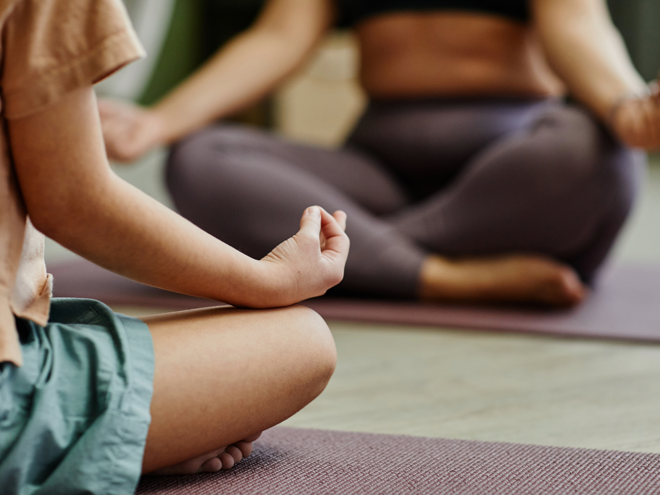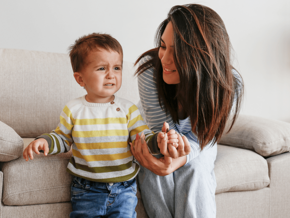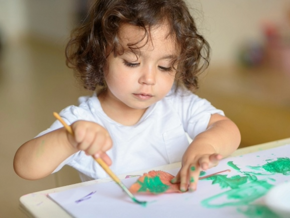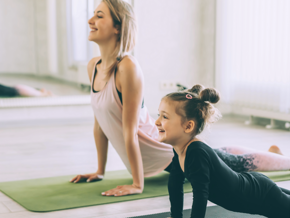
What is mindfulness and meditation for kids?
Simply put, mindfulness is the practice of being present in the moment with a sense of curiosity and acceptance. This nurturing approach is gaining popularity among parents and teachers as it encourages kids to be more aware of their thoughts, feelings and surroundings. When children pause and reflect, they develop a deeper understanding of themselves and their responses to the world around them, which in turn helps build emotional intelligence, resilience and a sense of calm.
With various ways to practice mindfulness, children can explore techniques that resonate with them. Guided kids' meditation is a particularly effective form of mindfulness for little ones. Unlike traditional adult meditation, which may involve longer sessions of silent reflection, guided meditation for kids is typically shorter and involves storytelling. Guiding them to recognise the sound of a gentle breeze, the warmth of the sun, or the vibrant colours of a magical landscape keeps them engaged while still benefiting from relaxing ‘down time’ needed to rest and recharge their active brains.
There is a positive link between mindfulness and early brain development. As kids engage in mindfulness practices, they gain essential skills that contribute to brain development like improved attention span, memory, and emotional regulation. These skills are valuable life skills that support learning and emotional well-being.
Key benefits of mindfulness and meditation for kids
Practicing mindfulness and meditation can benefit children in many ways, including:
- Improved focus: Mindfulness can help your little ones’ concentration during play or learning activities, such as drawing or origami, allowing them to engage more with their creativity.
- Better emotional awareness: Mindfulness can help fine tune emotional awareness in children by developing their self-regulation skills. This can hopefully mean fewer meltdowns and tantrums, especially among older toddlers.
- Bedtime calmness: Incorporating mindfulness practices leading up to bedtime can create a sense of calm during bedtime, making transitions easier and promoting a more restful night’s sleep.
Easy ways to start meditation for kids at home
Introducing mindfulness and meditation to your children doesn't require expensive or extensive preparation. Here are some practical tips for those who are new to these practices:
Create a calm and inviting meditation space
Setting the scene for meditation will help your little one get comfortable and focused. Just a few simple adjustments can make a big difference in creating a welcoming atmosphere that invites relaxation. Consider dimming the lights and choosing a cosy corner of your home filled with cushions or blankets. Additionally, try and remove distractions like toys or screens to help them keep focus. Remember, all that's truly needed is a calm voice and a quiet environment to guide your child into a peaceful state of mind.
Pick the right moments for mindfulness
Timing can have an impact on the effectiveness of mindfulness sessions. Look for natural opportunities throughout the day when your child may benefit from a moment of calm. Ideal times for short meditation or mindfulness practices could include:
- Winding down before bed, allowing your little one to transition smoothly into sleep;
- After an energetic play session, helping them to relax and process their emotions; or
- Just before preschool, easing any separation anxiety they may feel.
By using these moments as opportunities to connect with their feelings, you can help your child identify mindfulness as a comforting or calming part of their daily routine.
Meditation and mindfulness activities for kids
Starting with just short sessions of only 1 to 3 minutes can make mindfulness activities more manageable for children when its first being introduced. Here are some age-appropriate techniques to consider:
- Guided breathing games: Playful breathing exercises is a super easy beginner mindfulness activity for kids. You can say, “Let’s smell the flower,” encouraging them to inhale deeply through their nose, and then “Now blow out the candle,” prompting them to exhale slowly through their mouth. This helps children learn to control their breath while keeping them engaged.
- Story-style meditations: Use calming narratives to guide your child through imaginative scenarios. Create a simple story that takes them on a peaceful journey, such as a walk through a serene forest or a visit to a magical garden. This technique captures their attention and allows them to visualise a calming place.
- Soft instrumental music or nature sounds: Playing gentle instrumental music or soothing nature sounds can create a peaceful atmosphere for meditation. Sounds like ocean waves or birds chirping can help hold your child’s attention and promote relaxation.
- Guided meditations: Utilise free mindfulness resources online that offer guided meditations for preschoolers. These videos often feature engaging visuals and soothing voices, making it easier for kids to follow along and enjoy the activity. Try a quick online search to access free videos.
- Combine movement and breathing: Yoga is fantastic mindfulness activity for kids that combines movement with breath awareness. To learn more about the benefits of yoga for young children, check out our article on Benefits of Yoga for Preschoolers
Remember to follow your child's cues during these activities. If they seem disengaged or restless, it's perfectly okay to try again another time. The key is to make mindfulness for kids a positive and enjoyable experience for them.
Making mindfulness for kids a daily habit
Encouraging mindfulness as a daily habit is the best way to get your little one efficient at using this as a strategy to remain calm and get comfortable with situations thrown their way. It's important to approach this practice with a gentle and positive mindset, and consistency is key. Even small moments of mindfulness every day can have an impact on their resilience as they grow.
Tips for practicing mindfulness for kids
Here are some practical tips and ideas for incorporating mindfulness into your daily life:
- Start the day with a ‘quiet moment’: Set aside a few minutes for a quiet moment together every morning. Encourage your little one to take deep breaths, get them thinking about what they’re looking forward to today, or simply enjoy the peacefulness of the morning.
- Mindful transitions: Use moments of transition throughout the day, such as moving from playtime to mealtime, as opportunities for mindfulness. Encourage your child to take a few deep breaths before switching activities, helping them to focus and prepare for what’s next.
- Bedtime wind-downs: Create a calming bedtime routine that includes mindfulness practices. This could involve reading a story they love, practicing gentle stretches, or engaging in a short guided meditation.
- Nature walks: Incorporate mindfulness into outdoor activities by taking nature walks. Help them observe their surroundings, listen to the sounds of nature, and notice the sensations of walking across different surfaces.
- Mindfulness moments: Throughout the day, look for opportunities to pause and practice mindfulness. Whether it’s during snack time or while waiting for an appointment, take a moment to breathe together and appreciate the present moment.
A small practice with a big impact
Incorporating guided meditation for preschoolers and other mindfulness practices into a daily routine can offer numerous emotional and developmental benefits for you, your child and the whole family. Approach any new mindfulness activity for kids with flexibility. There is no “perfect” way to practice mindfulness, and every family's routine will look a little different. What matters most is that you create a supportive environment where your child feels comfortable exploring their thoughts and feelings. Trust that even the simplest practices can make a meaningful impact. Allowing your little one to master the skills of mindfulness will help them keep calm, enhance focus, and promote emotional awareness – benefits that they can take with them through life.
Frequently asked questions about mindfulness for kids
What age can kids start meditating?
Meditation for kids can start as early as 3 to 4 years old, although the approach should be adapted to their developmental stage. At this age, short sessions of 1 to 3 minutes using playful techniques, such as guided breathing games or storytelling, can be effective in introducing them to the practice of mindfulness.
How to teach meditation to a 4 year old
To teach meditation for kids that are 4-years-old, begin with simple and engaging activities. Use guided breathing exercises, such as “smell the flower, blow out the candle,” to make it fun. Incorporate story-style meditations that capture their imagination and keep sessions short—around 1 to 3 minutes. Creating a calm environment and using gentle, encouraging language can help them feel comfortable and engaged.
What is mindfulness for preschoolers?
Mindfulness for kids involves teaching them to be present in the moment and aware of their thoughts, feelings, and surroundings. It encourages them to observe their emotions and helps them develop skills for emotional regulation, focus, and relaxation. Mindfulness activities for kids this age are often playful and imaginative, making them accessible and enjoyable.
Which meditation is good for kids?
Guided meditations for preschoolers are a great starting point. They often include calming narratives, breathing exercises, and visualisation techniques. Story-style meditations that incorporate imaginative scenarios can capture their attention, while short sessions using soft music or nature sounds can create a soothing atmosphere. Searching online for free guided meditation for preschoolers can get you started and provided inspiration for new ideas along the way.
Is mindfulness good for kids with ADHD?
Yes, mindfulness can be beneficial for kids with ADHD. For some, it can help improve focus, emotional regulation, and self-awareness, which can be particularly helpful for managing symptoms of ADHD. Mindfulness activities for kids with ADHD can provide them with tools to calm their minds, reduce impulsivity, and enhance their ability to concentrate, making it a valuable addition to their daily routines.
Sources:
- Raising Children’s Website. Accessed at Mindfulness for parents, kids and teens | Raising Children Network
- Smiling Mind Evidence based guidelines for mindfulness in schools. Accessed at Smiling_Mind_03.pdf






